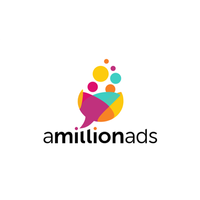A Millions Ads x London College of Communication
Earlier this year, 3 postgraduate courses in the Media School participated in a collaborative project which connected creativity and academic knowledge with vital industry insight. Students from MA Advertising, MA Public Relations and MA Media, Communications and Critical Practice were invited to develop and pitch digital advertisements that could enhance support for CLIC Sargent - the UK’s leading cancer charity for children, young people and their families, and a client of advertising technology company, A Million Ads.
Founded in 2015, A Million Ads is 'the personalisation expert', using data to create digital audio and video content that can better connect brands and organisations with their audiences. Unlike more traditional advertising where static messaging is communicated to relatively broad demographics, A Million Ads use a range of data points about a user to generate a highly personalised experience with enhanced context and relevance – for example, by considering their location, weather or time of day. As a result, campaign messaging across digital audio and video platforms becomes more effective and demonstrates greater impact, creating better ad experiences for the end consumer.
Working in cross-course teams, students worked with A Million Ads to develop their response to the CLIC Sargent brief, conducting their own research into audience behaviours before using their innovative tech platform to develop and test ideas for a concept campaign. Each team then presented their suggestions to an expert panel who provided invaluable feedback before choosing their favourite idea. One panel member commented: "I wanted to send a note to say what a delight it was to listen and see your students’ pitches. The quality and creativity of their presentation were simply outstanding!"
We chatted to a member of the winning team, MA Public Relations student Lucy Cotman-Morrison, and Kim Aspeling, Head of Creative Solutions at A Million Ads, about their experiences of the project, as well as the importance of connecting education and industry for both students and businesses alike.
Lucy, tell us about the project – what was your team brief?
We were asked to create a dynamic audio advertisement for the charity CLIC Sargent, which provides support to children facing a cancer diagnosis, as well as their families. We were introduced to the project by the team at A Million Ads, who were kind enough to let us use their software to produce our prototype.
A Million Ads is an ad tech company known for their use of dynamic advertising, which means that rather than everyone hearing the exact same ad, each listener is able to hear a more personalised version - often taking into account factors such as location, weather, and time.
Kim, why do you feel that collaborating with LCC was a good fit for A Million Ads?
London College of Communication has a reputation for building independent thinkers. It's a place where differences and innovative thinking are welcomed, and these values are also core to our organisation too.
Our thinking, our product and our culture is all about welcoming different and encouraging opinions from everyone within the business in order to create a product that continues to innovate and push creative boundaries. Thus, we felt that a collaboration between A Million Ads and LCC would not only be a great fit, but that we would be able to gain access to insights outside of our usual advertising realm.
Lucy, how did your team begin to develop a response to your client brief, and how did you get involved?
My group was made up of students from 3 different MA courses — Public Relations (the course that I’m on), Advertising, and Media, Communications and Critical Practice. Because of this, all of us had very different ideas on the best way to approach the brief, and there was a lot of discussion and critical analysis during our creative process. We talked a lot about - and did a lot of research on - who our target audience was, and what could convince them to donate their time or money to a charity.
From there, we were able to decide who would be speaking in our advertisement, the perspective we would take, how we could incorporate “dynamic” lines, and what emotions we could tap into while ensuring we weren’t exploiting the trauma of childhood cancer.
Throughout the Collaborative Unit, I was fortunate enough to have a hand in a lot of different aspects of our project. My main roles involved researching how people in the UK relate and respond to cancer and charities, and producing a communications audit for CLIC Sargent. I also contributed to the writing of the script, and the putting together of our pitch deck.
Kim, how have our MA students been able to support your work through their suggestions?
The vast differences between each of the students' ideas showed just how much is possible with a brief and the data points provided.
When people initially start using data and personalisation, the number of creative opportunities available can feel overwhelming, which means people often simplify the scripts so much that it doesn't feel like an original idea. However, the students showcased how the simplicity of using just 1 or 2 data points combined with the right creative execution can actually open up doors to many different ideas and concepts. This is something we want to encourage industry-wide when working with external creative agencies and partners.
Another key learning was not to over-complicate the process. When we initially spoke to the students, we kept the training straightforward and simple, but afterwards worried that they didn't have enough information and there would be loads of follow-up questions. This was actually not the case - we learnt that our system and processes are extremely intuitive, and so can focus our priorities on developing the product to be even more seamless.
What the highlights of the project from both an academic and an industry perspective?
Lucy: For me, the main highlight of the project was definitely having our pitch chosen as one of just 6 that got to be presented to both our client and several people from A Million Ads. Having feedback from people already working in the industry was invaluable, and reassured me that the work I’ve done on my course is relevant and helpful in the real world.
My other highlight would be finding out a few weeks after the fact that my group was chosen as having the best pitch by the Head of Creative Solutions, Kim. I had no idea they were going to be choosing a winner from the groups who presented to them, so it was an amazing surprise to pop up in my email after having worked so hard on the project for months.
Kim: Being exposed to young creative minds who are still very new to the industry is such a highlight, as it allows us to gain knowledge, insights and ideas from people who have not yet been moulded by the industry or have self-imposed constraints due to their previous work experience.
The enthusiasm of the students and the absolute high standard of work that was brought to the table was also a massive highlight. To see students really giving it their all from a conceptual and executional perspective reawakened our energy and passion for advertising, and inspires us to bring this to every single work day.
Our engineers also had a chance to spend some one-on-one time with the students to get constructive feedback on the product, which was extremely valuable but also encouraging to hear that the direction that the product is headed in is on par with what the advertising industry needs.
Kim, why is it important for A Million Ads to take part in collaborative projects that connect you to emerging creatives?
As a creative ad tech platform, it's important for us to continue to revive our creativity and our ideas by tapping into the worlds and minds of people we don't regularly have access to. As our platform continues to develop, we also want to ensure that the growth of the product is shaped by creatives who are just starting out in the industry as they will be the future of creative advertising.
By taking part in collaborations like this one, we can use the knowledge and connections gained to share and pay it forward with the media, creative and advertising industry as whole. This will hopefully lead to job placements for the next generation of students, but also ensure that the industry keeps evolving and becoming a more innovative, inclusive and creative place to work in.
Lucy, what have you enjoyed most about studying at LCC?
I’ve enjoyed how many opportunities there are to learn and grow.
During my undergraduate degree, I often felt like a small fish in a very large pond—maybe even an ocean. However, since starting my MA at LCC, I’ve gotten to know all of my lecturers and tutors really well, attended industry events for free that normally would have cost hundreds of pounds to attend, and built a strong community with my course-mates, even with having to do most classes remotely.
The course leadership has also made sure that we’re always aware of the opportunities and advantages available to us as LCC students, which has allowed me to make the most out of the programme and the College.
Related links:
- Explore the work of A Million Ads. and CLIC Sargent.
- Find out more about MA Advertising, MA Public Relations and MA Media, Communications and Critical Practice at LCC.
- Learn more about our Media School.


